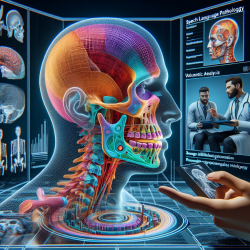Introduction
The realm of maxillofacial analysis is evolving rapidly, thanks to advancements in three-dimensional (3D) imaging technologies. The recent scoping review titled "Volumetric Analyses of Dysmorphic Maxillofacial Structures Using 3D Surface-Based Approaches" provides a comprehensive overview of the current landscape of 3D imaging methods for analyzing dysmorphic maxillofacial structures. This blog post aims to distill the key findings of the review and explore how practitioners can leverage these insights to enhance clinical outcomes, particularly in pediatric settings.
Why 3D Imaging Matters
Maxillofacial dysmorphisms, whether congenital or acquired, can significantly impact a child's life, affecting functions such as breathing, speech, and feeding. Traditional two-dimensional (2D) methods fall short in capturing the complexity of these structures. 3D imaging, however, offers unparalleled accuracy and precision, enabling detailed qualitative and quantitative assessments. This is particularly beneficial for conditions like cleft lip and palate (CL/P), where precise volumetric data can guide surgical planning and post-operative evaluations.
Key Findings from the Scoping Review
The review analyzed 17 studies, highlighting the diverse methodologies employed in 3D volumetric analysis. Despite the heterogeneity in protocols and technologies, a few key themes emerged:
- Technological Diversity: The studies utilized a range of 3D technologies, including stereophotogrammetry and laser scanning, each with its own strengths and limitations.
- Protocol Variability: There is a lack of consensus on standardized protocols for volumetric analysis, which complicates data comparability across studies.
- Clinical Relevance: Despite methodological differences, the studies underscore the clinical value of 3D volumetric data in improving surgical outcomes and understanding dysmorphic conditions.
Implications for Practitioners
For speech-language pathologists and other practitioners working with children, the insights from this review offer several actionable takeaways:
- Embrace 3D Technologies: Incorporating 3D imaging into clinical practice can enhance diagnostic accuracy and treatment planning. Practitioners should advocate for the adoption of these technologies in their institutions.
- Standardize Protocols: Collaborate with interdisciplinary teams to develop and adhere to standardized protocols for 3D volumetric analysis. This will facilitate data comparability and improve clinical outcomes.
- Focus on Training: Ensure that clinical teams are adequately trained in using 3D imaging technologies and interpreting volumetric data. This is crucial for maximizing the benefits of these advanced tools.
Encouraging Further Research
The review highlights the need for more rigorous studies to establish reliable protocols and reference data for 3D volumetric analysis. Practitioners are encouraged to contribute to this growing body of research by participating in studies and sharing clinical experiences. Collaborative efforts will pave the way for standardized practices and enhance the utility of 3D imaging in clinical settings.
To read the original research paper, please follow this link: Volumetric Analyses of Dysmorphic Maxillofacial Structures Using 3D Surface-Based Approaches: A Scoping Review.










